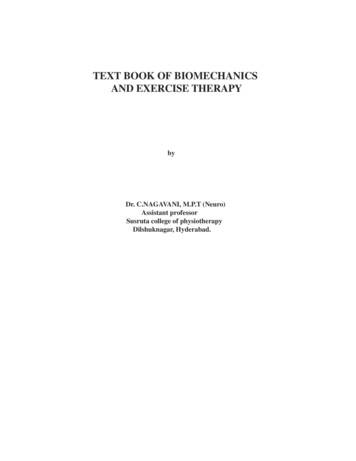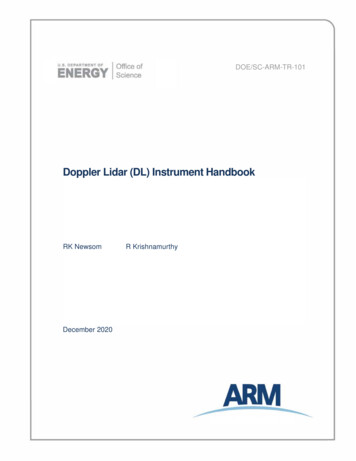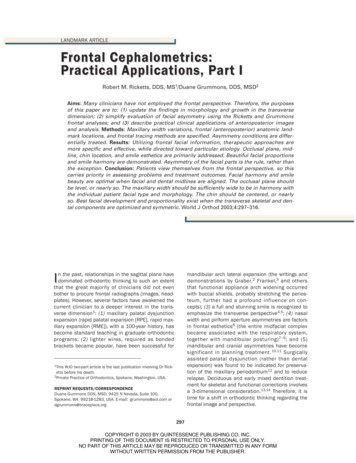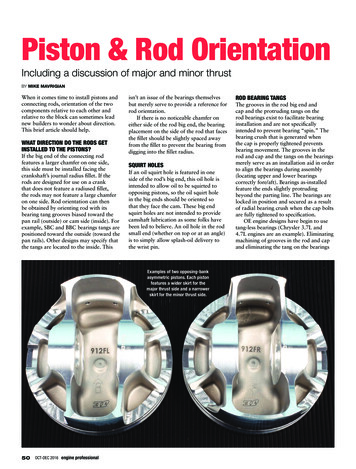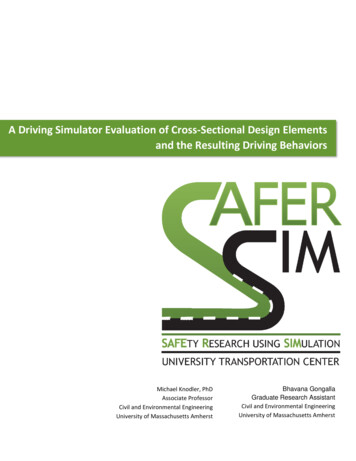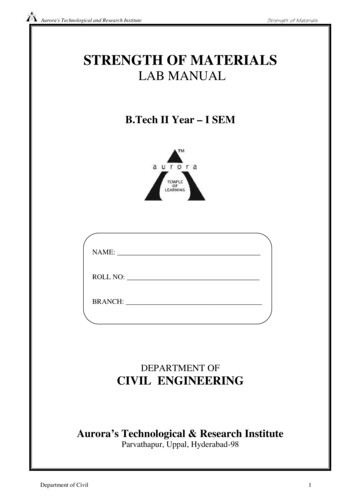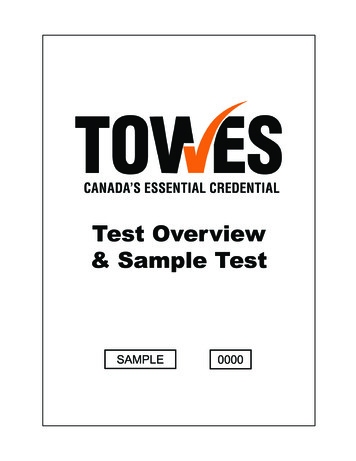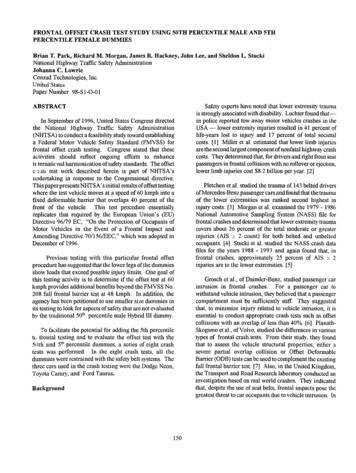
Transcription
FRONTAL OFFSET CRASH TEST STUDY USING 50TH PERCENTILE MALE AND 5THPERCENTILE FEMALE DUMMIESBrian T. Park, Richard M. Morgan, James R. Hackney, John Lee, and Sheldon L. StuckiNational Highway Traffic SafetyAdministrationJohanna C. LowrieConrad Technologies,Inc.United StatesPaper Number 98-Sl-0-0 1ABSTRACTIn Septemberof 1996,United StatesCongressdirectedthe National Highway Traftic Safety Administration(NHTSA) to conducta feasibility studytoward establishinga Federal Motor Vehicle Safety Standard (FMVSS) forfrontal offset crash testing. Congress stated that theseactivities should reflect ongoing efforts to enhanceir ternationalharmonizationof safetystandards.The offsetc .:.shtest work described herein is part of NHTSA’suadertaking in responseto the Congressionaldirective.This paperpresentsNHTSA’s initial resultsof offsettestingwhere the test vehicle movesat a speedof 60 kmph into afixed deformable barrier that overlaps 40 percent of thefront of the vehicle. This test procedure essentiallyreplicates that required by the European Union’s (EU)Directive 96/79 EC, “On the Protection of OccupantsofMotor Vehicles in the Event of a Frontal Impact andAmending Directive 70/156/EEC,”which was adoptedinDecemberof 1996.Previous testing with this particular frontal offsetprocedurehas suggestedthat the lower legs of the dummiesshow loads that exceedpossibleinjury limits. One goal ofthis testing activity is to determineif the offset test at 60kmph providesadditional benefitsbeyondthe FMVSS No.208 full frontal barrier test at 48 kmph. In addition, theagencyhas beenpetitioned to use smaller size dummiesinits testing to look for aspectsof safetythat are not evaluatedby the traditional 50ti percentilemale Hybrid III dummy.To facilitate the potential for adding the 5th percentiletc frontal testing and to evaluatethe offset test with the50th and 5’ percentile dummies, a series of eight crashtests was performed. In the eight crash tests, all thedummieswere restrainedwith the safetybelt systems.Thethree cars used in the crash testing were the Dodge Neon,Toyota Camry, and Ford Taurus.Background150Safetyexpertshave noted that lower extremity traumais strongly associatedwith disability. Luchterfound that in police reportedtow away motor vehicles crashesin theUSA - lower extremity injuries resultedin 41 percentoflife-years lost to injury and 17 percent of total societalcosts. [l] Miller et al. estimatedthat lower limb injuriesarethe secondlargestcomponentof nonfatalhighway crashcosts. They determinedthat, for driversandright front seatpassengersin frontal collisions with no rollover or ejection,lower limb injuries cost 8.2 billion per year. [2]Pletchenet al. studiedthe trauma of 143belted driversof Mercedes-Benzpassengercarsandfoundthat the traumaof the lower extremities was ranked second highest ininjury costs. [3] Morgan et al. examinedthe 1979 - 1986National Automotive Sampling System (NASS) file forfrontal crashesand determinedthat lower extremity traumacovers about 26 percent of the total moderateor greaterinjuries (AIS 1 2 count) for both belted and unbeltedoccupants.[4] Stucki et al. studied the NASS crash datatiles for the years 1988 - 1993 and again found that, infrontal crashes, approximately 25 percent of AIS 1 2injuries are to the lower extremities. [5]Grosch et al., of Daimler-Benz, studiedpassengercarintrusion in frontal crashes. For a passengercar towithstand vehicle intrusion, they believedthat a passengercompartment must be sufficiently stiff. They suggestedthat, to minimize injury related to vehicle intrusion, it isessentialto conduct appropriatecrash tests such as offsetcollisions with an overlap of less than 40%. [6] PlanathSkogsmoet al., of Volvo, studiedthe differencesin varioustypes of frontal crash tests. From their study, they foundthat to assessthe vehicle structural properties, either asevere partial overlap collision or Offset DeformableBarrier (ODB) testscanbe usedto complementthe existingfull frontal barrier test. [7] Also, in the United Kingdom,the Transport and don real world crashes. They indicatedthat, despitethe use of seatbelts, frontal impacts posethegreatestthreat to car occupantsdueto vehicle intrusion. In
that study, they suggestedthat there is a needfor a test inwhich the barrier is offset and a deformableimpact face isused. [S] In the U.S., beginning in 1995, the InsuranceInstitute for Highway Safety (IIHS) initiated a programusing a frontal offset test to rate safety in cars. Thisongoing frontal offset testing program evaluates thecrashworthinessof new modelvehiclescrashedat 64 kmph(40 mph) into a deformable barrier. Based on theirexperience, they indicated that a full-width test and afrontal offset test complementeachother; a full-width testis especiallydemandingof restraints, while the offset testis demandingof the structural integrity of a vehicle. [9]In 1996,Australia studiedthe benefitsof a frontal offsetregulation. In their study, they found that adding theEEVC frontal offset requirementto the Australia‘s FederalOffice of Road Safety (FORS) dynamic full frontal crashstandard(ADR 69, similar to FMVSS No. 208) would behighly beneficial and cost effective. [lo]and injury criteria prescribed in the FMVSS No. 208standard and the EU Directive 96/79/EC differconsiderably. The differences are listed in Table Al ofAppendix A.IFMVSS No. 208NHTSA’s Frontal Offset Harmonization StudyIn Septemberof 1996, Congressdirected NHTSA toconduct a feasibility study toward establishing a Federalmotor vehicle safety standard for frontal offset crashtesting. In that directive, Congress stated, “.such astandardwill enhanceautomobilesafetyfor all consumers.Further, these activities should reflect ongoing efforts toeihanceinternationalharmonizationof safetystandards.”The offset test program described herein is part ofNl-ITSA’s undertaking to form standards that providebenefits and reflect efforts to strengthen world wideharmonization. [ 11]Figure 1. Test configurations of FMYSS No. 208 and theEU-offset Deformable Barrier tests.In Decemberof 1996,the EuropeanParliamentadoptedDirective 96/79 EC, “On the Protection of OccupantsofMotor Vehicles in the Event of a Frontal Impact andAmending Directive 70/156/EEC.” Directive 96/79/ECrequires a 40% frontal offset test of a vehicle into adeformable barrier at 56 kmph, with a restrained 50thpercentileadultHybrid III anthropomorphicdummy. Also,in Australia, the FederalOffice of Road Safety(FORS) isconsideringadoptingAustralian Design Rule (ADR) 73/00Offset Frontal Impact Occupant Protection, which isidentical to theDirective 96/79EC. Furthermore,in Japan,since April 1993, the Ministry of Transport (MOT) hasbeen researchinga frontal offset test proceduresimilar toDirective 96/79 EC5thPercentile Female Hybrid III DummyIn Figure 1, the conligurations of the FMVSS No. 208test and the EuropeanParliament adoptedDirective 96/79EC frontal 40% offset test are shown. The test conditionsEU 96179In 1997, the CanadianGovernmentcarried out a testprogram to validate the 40% offset crash test proceduredesignated in the Directive 96/79 EC. Four separatepassengercarswere crashedat the speedof 56 kmph and ata higher speedof 60 kmph. In that study, at the impactspeed of 60 kmph, the lower leg readings exceededtheallowedtibia criteria of the EU (EuropeanUnion) Directivethree times out of eight.[l2] Based of that study, theEuropeanParliamentandAustralian FORSareconsideringincreasingthe impact speedto 60 kmph.In Septemberof 1996, the American AutomobileManufacturersAssociation@AMA) petitionedNHTSA tochange the FMVSS No. 208 testing specifications. [13]Among other items, the petition requestedthe useof the 5thpercentile adult female Hybrid III dummy in FMVSS No.208. Subsequently,the NHTSA receiveda secondpetitionto incorporatethe 5th percentilefemale Hybrid III dummyinto FMVSS No. 208. [ 141The size of the occupantmay beimportant in determining the safety value of different
frontal crash procedures. Previous researchinto frontalcrashprotectionhassuggestedthat traumarisk levelsdifferby occupantsize. [5] The general description and relativeseating configuration of various adult dummy sizes areincluded in Table A2 and Figure Al of Appendix A.To use the 5’hpercentile female Hybrid III dummy invehicle testing, a common seating procedureneedsto beestablished.In July of 1997,a specialtask force of the SAEDummy TestEquipment Subcommitteemet at EastLiberty,Ohio, to draft a seating procedurefor the 5’ percentileadult female Hybrid III dummy to use in passengercars.Representativesfrom Chrysler, Ford, General Motors(GM), IIHS, KARCO, NHTSA, Toyota, TransportationResearchCenter,Transport Canada,and the University ofMichigan were present. Existing seatingprocedureswerestudied and all parties agreed on a procedure,which isbeing finalized by the SAE subcommittee.typical instrumentedlower leg is configuredwith load cellsat the upper and lower tibia with a 45 degreedorsiflexionangle foot with a rubber stopper. In this test series, theconfigurations of the instrumented legs used for the twodummy sizes are slightly different. The difference is thatthe 50ti percentile male dummy configured with a singleaxis load cell (measuresmomentsaboutthey-axis) whereasthe 5* percentilefemale dummy configuredwith dual axesload cells (measuresmomentsabout x and y axes).Table 1.Test Matrix for the 1997 NHTSA’s EU-offsetFrontal Test5th% female dummWith the developmentof the 5* percentile femaledummy seating procedure,NHTSA began frontal offsettesting. The objectivesof this testing are to (1) evaluatepotential benefits of adopting the frontal offset test as asupplementto FMVSS No. 208 and (2) to evaluatethe useof the 5* percentilefemale dummy in both the FMVSS No.208, restrained test condition and in the offset testcondition.J data already exists for this test condition andmake model combination [ 121Crash Test MatrixThe agency crashedeight cars to understandthe EUfrontal offset and the responseof the 5& percentile femaledummy. Testswere conductedwith three modelyear 1996passengercars - Dodge Neon, Toyota Campy,and FordTaurus - using two dummies, the 50th percentile maleHybrid III dummy and the 5th percentilefemale Hybrid IIIdummy. The tests were conducted using all availablerestraints The conditions of the eight tests are shown inTclblc:1.Vehicle selection was basedon choosingvehicles forwhich (1) frontal impact test data already exist, (2) thereare a large number of thesecars sold in the U.S., and (3)there is a salespresenceof thesecarsthroughoutthe world.Of the three vehicles chosen,the Dodge Neon was one ofthe passengercars testedby Transport Canada.[121 TheFord Taurus and the Toyota Camry are two passengercarsthat havebeentestedextensivelyby NHTSA and IIHS.All testing used the full instrumentation packageavailablefor the Hybrid III dummies. In this study, one ofthe primary interestsis evaluatingthe lower extremity. A152In eachtest of their car, engineersfrom Chrysler,Ford,and Toyota assisted the NHTSA with seating the 5thpercentile female dummy. For most of the tests, themanufacturer’srepresentativesactively participated in thetest setup. All the test results have been compiled intoreports, films and videos and are available through theNHTSA’s public dockets (Docket number: NHTSA 983332).RESULTS AND DISCUSSIONAll of the dummy responsesfrom the testsare tabulatedin Tables A3 and A4 of Appendix A, for the driver andright front passenger, respectively. In the followinganalyses,the differencedummy responsesare comparedinterms of values that have been normalized to thepreliminary injury criteria andInjury AssessmentReferenceValues (IARV) that are given in Table A5 of Appendix A.As the notes in this table indicate, many of the referencevalues are preliminary and subjectto change,particularlythose associatedwith the 5& percentilefemale dummy.
Head, Chest, and FemursNeon are considerablyhigher in the EU test.In Figures 2, 3, and 4, the headand chest responsesofthe S” percentile female Hybrid III are comparedfor theFMVSS No. 208 frontal test and the EU-offset test at 60kmph. Note that the normalized responsesare usedin thefigures. In general,the readingsfrom the FMVSS No. 208tests are either about the sameor higher than those fromEU-offset tests. Exceptionsare that the chestdisplacementresponsesfor the driver and right front passengerfor theThe comparisons of the femur loads are shown inFigures 5 and 6. In the El-J-offsettest, the femoral loadingis higher in the driver’s lefi leg than in the right For thepassenger,the femoral loading is generally higher in theFMVSS No. 208 test. However, in each of fivecomparisons,none of the readingsexceededthe allowableinjury criteria. In fact, most of the readingsare far belowthe allowable limit.1.0 ,IIq EU(GO)-beltedq PassTaurusPass5th5thCamfyPassFigure 2. Head Injury Criterion (HIC) comparison.,0.8qq% o.6‘;j 0.4c3 0.2EUlGO)-belted DriverNeonPassTaurusPassCamtyPassFigure 3. Chest acceleration (3ms clip) comparisonz0.89‘p0.60.4s0.2qq0.0Figure 4. Chest displacement comparison153ElJ(GOl-belted 5th208(48)-belted5th
1 1tj22I0.8 !q EUW-beltedq CamtyLeftNeonRightTaurusRightCamryRightFigure 5. Driver femur comparisonI1.01 5 0.8I z 0.6t m 0.4sI[gEUlGO)-belted 5thq NeonRightTaurusRightCamryRightFigure 6. Right front passengerfemur comparison.Lower Extremityshown. In the Taurus, all values are below the referencevaluesand are similar for both test types,Doesthe EU-offsettest demonstratethat the loadsto thelower extremitiesaregreaterthan thosein the F’MVSSNo.208 test? How do the lower extremity loadsdiffer betweenthe two dummytypes- the SOtipercentilemaleandthe 5thpercentilefemale? In this test series,the lower extremitydata for the driver and right front passengerare collectedfor all tests. However, becauseof the benign responsesexhibited from the right front passengerdummy in theoffset tests, the following discussionwill be limited to thedriver dummy. The right front passengerdummy readingsare in Table A4 of Appendix A for the interestedreaders.Two types of lower limb analyses are made: acomparisonbetweentest types given both used the 5’percentile female dummy and a comparison of the 5’percentile female and the 50’ percentile male dummiesgiven both were exposedto EU-offset test conditions. Forthis lower extremity comparison,the injury criteria for theupperandlower tibia momentsandfoot/ankleaxial loadingforces are examined. For the tibia bending momentcomparisons,resultantbendingmomentsare usedexceptfor the lower leg data for the 50* percentilemale dummy- only the bendingmomentsabouty-axis were available.First, the lower limbs of the ?’ percentile femaledummy were examinedbetweenthe two test types. InFigures7 and 8, the comparisonsof left and right legs are154In the Camry, all valuesexceptthe lower tibia momentare below the referencevalues. The right lower tibiamoment in the EU-offset test is considerablyhigher thanthat observedin the FMVSS No. 208 test. When thedifferenceis calculatedfor the right lower tibia moment,the readingfor the EU-offset test is greaterby 103%.In the Neon, higher tibia forcesand momentsoccurredin bothtest typesthanfor the Taurusand Camry. The axialforce referencevalue is exceededin the FMVSS No. 208test andthe upperand lower tibia momentreferencevaluesare exceededin both test types. Of the four tibia momentcomparisonsfor the Neon,betweenthe two test types, thereadingsof the 5’ percentilefemale exceedthe allowablecriteria in six out of the eight responses.When the percentdifference is calculatedbetweenthe two test types, thereadingsfor the EU-offset testfor Neonat the left and rightlower tibia bending moments are higher by 137% andlOl%, respectively. By contrast, the left upper tibiamomentfor the Neon in the FMVSS No. 208 test exceedsthe responsefrom the EU test by 75%.Second,doesthe 5’hpercentilefemale dummy exhibitany differencein loadingsto the lower limbs as comparedto the 50”percentilemale dummy underthe EU-offset testcondition? The lower limb comparisonsbetweenthe 5”
the two dummy types with all responsesmeeting thereferencevalues.percentilefemale and the 50ti percentilemale dummiesforthe EU-offset tests are shown in Figures 9 and 10. For theTaurus, little difference is noted betweenthe responsesof2.021.531.0g0.50.0L J TibiaNeonl&TibiaTa W0.SLp TibiaCamryioTibiaNeonLo TibiaLo TibiaTSWrUSCampyA&lFAxidFAkdTa URISNeonFjCamryFigure 7. Driver left leg tibia comparison of the 5th percentile female dummybetween the EU-offset and the FMVSS No. 208 lted 5th0.0Lp Tibial&TibiaL@ TibiaTa UIUSNeonCampyLo TibiaNeonLo TibiaLo TibiaT WUSCampyA.&lFNeonAxhdFT&WrlJ.SAxMFCampyFigure 8. Driver right leg tibia comparison of the 5th percentile female dummybetween the EU-offset and the FMVSS No. 208 tests.qICp TibiaNeonUp TibiaL&I TibiaLa TibiaLo TibiaLo TibiaTa WUSCampyN&P/lTZWrclsCamryA.&lFNeonEUlGO)-belted 50thAd&IFAtiatFTa UIUSCamryiFigure 9. Driver left leg tibia comparison between the two dummy typesin the EU-offset test.2.52.01.51.00.50.0&TibiaNeonl&TibiaTa WUSl&TibiaCamryLo TibiaNeonLo TibiaTa lJrlI.SLo TibiaCamryAx&IFNl?OflA.&IFAxGaIFTa0rO.SCampyFigure 10. Driver right leg tibia comparison between the two dummy typesin the EU-offset test.155
For the Camry, again, most responsesare similar forthe two dummiesexceptfor the right lower tibia moment.When the difference is calculated,at the right lower tibiafor Camry, the reading for the 5th percentile dummy isgreaterby 115% than for the 50* percentile male dummy.The reading for the 5” percentile female exceedsthereferencevalue whereasthe 50” percentile male doesnot.For the Neon, the right tibia momentof the 5&percentilefemale is greater by 124% than the 50* percentile maledummy - both readingsexceedthe referencevalue. Bycontrast,for the left uppertibia moment,the readingof the50” percentile male dummy is greaterby 80%.In general,the comparisonsin Figures 7 and 8 suggestthat the higher dummy readings above the preliminaryreference values for lower tibia bending moment areexhibited in the ELI-offset test than the FMVSS No. 208test. In addition, the comparisonsin Figures 9 and 10suggestthat when the readingsfor the two dummies arecomparedfor the EU-offset test, the result showsthat the 5’hpercentilegenerallyshowsgreaterloads in the lower limbsthan the 50thpercentile male dummy in the EU-offset test.As discussedin the foregoing analysis, greater lowerlimb readingsmay be expectedfrom the EU-offset test. Itis also found, as expected,that generally greaterintrusionoccursin the EU teststhan in the FMVSS No. 208 tests. InTable A6 of Appendix A, the intrusion measurementsoftoepancollected from the test seriesare tabulated. Fromthese intrusion data, it is noted that the Neon, whichexhibited the higher lower leg responses, had the mostintrusion (about twice as much as the other two vehicles).Neck ResponseBecauseof its different anthropometricproperties,thesmall female may be exposedto different injury risks infrontal crashes than the mid-size male. In the previoussections, risks to the legs were explored. In this section,the potential for neck injury will be examined. For theneckevaluation,five injury criteria areexamined:fore-andaft shear, axial compression,axial tension, bending inflexion, and bending in extension. In reviewing thed.jmmy readings,the outcome revealsthat no significantn :%;k readings are found for the criteria of shear,compression, tension or flexion. However, the neckextension readings are consistently high (exceed thepreliminary referenceneck extension criterion of 31 Nmfound in Table A5) in the neck of the 5’ percentilefemale156dummy.To further evaluatethe neck extension criterion, twotypes of analyses are made: the comparison of the 5&percentilefemale and the 50fi percentile male dummiesinEU-offset test conditions and the 5’h percentile femaledummy comparison between the test types. In eachcomparison,the neck responsesfor both driver and rightfront passengerare included.First, the driver neck extensionsfor the two dummiestested under EU-offset test are compared and shown inFigure 11. For the 5* percentile female dummy, allreadingsexceedthe allowablelimit by 1.61, 1.23,and 1.57timesfor Neon, Taurus,and Camry,respectively.Whereas,for the 50thpercentilemale dummy, the readingfor Camryexceedsthe preliminary referenceneck extensioncriterionof 3 1 Nm, a pertinent neck criterion by 1.1 times.Figure 12 showsthe neck extensioncomparisonfor theright front passengerbetweenthe two dummy types testedfor EU-offset. In that comparison,the 5” percentilefemaledummy for Camry exhibits neck loading that exceedsthepreliminary referencevalue by 2.9 times (89 Nm). In thisparticular event,the maximum neck extensionoccurredat85 msec. Based on the high speed film analysis, thedummy’s neck is being hyper-extendedcorrespondingtothe time that the neck load cells readsthis maximum value.Second,the neck extensionreadingsfor the driver 5’percentile female dummy are comparedbetween the twotest types and the comparison is shown in Figure 13.Between the two test types, the readings exceed thepreliminary referencevalue five times out of six. Of thefive high responses,the two highest readingsare from theFMVSS No. 208 test for Taurus and Camry where thereadingsexceedthe preliminary referencevalue by 2.4 and2.1 times, respectively. Moreover, when the differenceinreadingsis calculated,the readingsfor theFMVSS No. 208are greater by 116% and 49% for Taurus and Camry,respectively. For the right front passengerdummy, Figure14 showsneck extensioncomparisonbetweenthe two testtypes. As canbe seen,neither the Neon nor Taurusexceedsthe preliminary referencevalue. However, the reading ofthe FMVSS No. 208 test for the Camq exhibits 5.6 timesthe preliminary referencevalue (172 Nm). When thedifference is cahzulated,the reading for the FMVSS No.208 test is greaterby 270% than the EU-offset test. Whenthe high speedfilm analysis is made, it shows that thedummy’s neck is being hyper-extendedat 73 msec.
comparedbetweenthe two test types, for both driver andright front passengerdummies, the readings from theFMVSS No. 208 test are higher than those from the EUoffset test.Therefore, based on the neck analysis, betweenthedriver and right front passenger,the readingsfor the driver5’ percentile female dummy exceed the preliminaryreferencevalue four times out of six. In addition, when theneck extensionfor the 5’hpercentilefemale dummy is2.0i51.521.0s0.51qEU(60-belted sExtensionCamtyFigure 11. Driver neck bending moment comparison between the two dummy typesin EU-offset test.3.0g2St2.0qq1.0EU(6Okbelted50thElJ(GO)-belted gure 12. Passengerneck bending moment comparison between the two dummytypes in EU-offset thElJ(GO)-belted 5thExtensionCamiyFigure 13. Driver neck bending moment comparison of the 9’ percentile femaleHybrid III between the two test types.6.01 re 14. Right front passengerneck bending moment comparison of the Shpercentile female Hybrid III between the two test types.157
the 50ti percentile male dummy responsesexceedsthepreliminary referencevalues.CONCLUSIONSThe U.S. Congressdirected NHTSA to investigate afrontal offset test procedurerequired by the EU Directive96/79 EC. The NHTSA also took this opportunity toinvestigatethe potential for addingthe Sr’percentilefemaledummy to a frontal flat barrier test and a frontal offset test.A seriesof eight crash testswas performed. In thesetests,all dummies were restrained. The three cars used in thetesting were the Dodge Neon, Ford Taurus, and ToyotaCamry.When the results for the Sfi percentile female dummyare comparedbetweenthe belted EU-offset test and thebelted FMVSS No. 208 test, it is found that the responsesfor head,chestand femur from the FMVSS No. 208 test areabout the same or slightly greater. By contrast, for thelower limb and neck criteria, considerabledifferencesarefound.Furthermore,when the readingsfor the 5” percentilefemale are compared,betweenthe two test types,the driver5* percentile female dummy exceeds the preliminaryreferencevalues five times out of six by factors of 1.23 to2.39. In addition, for the right front passenger,betweenthetwo test types,the 5fhpercentilefemale dummy exceedsthepreliminary reference values two times out of six, byfactors of 2.9 and 5.6. Of the sevenhighest neck readingsmentioned,the three highest readingsare exhibited from‘he FMVSS No. 20X test using the smaller dummy.REFERENCES(1)First, in the lower limb comparisons,when the readingsare comparedbetweenthe FMVSS No. 208 and EU-offsettests, the result suggeststhat the higher readings areexhibited more in the EU-offset test. For instance,in twooccasions,the tibia readingsfor the EU-offset test exceedthe preliminary referencevalues considerablywhereasforthe FMVSS No. 208 test these criteria are satisfied. Inaddition, when the lower limb readingsfor the two dummysizes are comparedin the EU-offset test, the results showthat the 5* percentilefemale exhibits considerablygreaterloadsthan the 50* percentilemale. In that comparison,inone occasion,the 5’hpercentilefemale dummy exceedsthepreliminary referencevalues whereasthe 50” percentilemale doesnot.Therefore,the result suggeststhat for the 5’hpercentilefemale dummy, the E&offset test provides an additionalbenefit in assessingtrauma in the lower limbs beyondthatof the FMVSS No. 208 test. Furthermore,it revealsthat inthe EU-offset test condition, the 5’h percentile femaledummy would likely produce higher lower limb readingsthan the 50thpercentile male dummy.Second,the neck criteria for the 5” percentilefemalea-rdthe 50thpercentile male dummies are evaluated. Theresultsshow that all of the neck criteria are satisfiedexceptfor the neck extensioncriterion. When the neck extensionreadingsfor the 5” percentile female are comparedto the50ti percentilemale dummy for the EU-offset test, betweenthe driver and right front passengerdummies, the 5thpercentilefemale exceedsthe preliminary referencevaluesfourtimesbyfactorsof 1.61, 1.23, 1.57and2.9-noneof158(2)(3)(4)(5)(6)(7)Luchter, S., “Long Term Consequencesof LowerExtremity Injuries,” International ConferenceonPelvic and Lower Extremity Injuries Proceedings,National Highway Traffic SafetyAdministration,U.S. Department of Transportation, December1995.Miller, T. R., Martin, P. G., and CrandaIl, J. R.,“Cost of Lower Limb injuries in HighwayCrashes,”International Conferenceon Pelvic andLower Extremity Injuries Proceedings,NationalHighway Traffic Safety Administration, U.S.Departmentof Transportation,December1995.Pletschen, B., Schunert, D., Deubert, M.,Herrmann,R., and Zeidler, F., “Application of theInjury Cost Scale (ICS) to Mercedes-BenzAccident Data,” Thirty-fourth Stapp Car CrashConferenceProceedings,November 1990.Morgan, R. M., Eppinger, R. H., and Hennessey,B. C., “Ankle Joint Injury Mechanismsfor Adultsin Frontal Automotive Impact,”Thirty-fifth StappCar Crash ConferenceProceedings,November1994.Stucki, S.L., Ragland, C., Hennessey,B., andHollowell, W.T., “NHTSA’s Improved FrontalProtection Research Program,” Society ofAutomotive Engineers,PaperNo. 950497, 1995.Grosch,L., Baumann,K, Holtze, H, and Schwede,W., “Safety Performance of Passenger CarsDesingedto AccommodateFrontal Impacts withPartial Barrier Overlap,” Automotive FrontalImpacts, Society of Automotive engineers,PaperNo. SP-782,19X9.Planath-Skogasmo,I., Nilsson, R., “Frontal Crash
(8)(91Test -A Comparisonof Methods,”Thirty-eighthStappCar Crash ConferenceProceedings,PaperNo. 942228,November1994.Hobbs,A. C., “The Needfor ImprovedStructuralIntegrity in Frontal Car Impacts,” ThirteenthInternational Technical Conference ber1991.O’Neil, B., Lund, A., Zuby, D., Estep, C.,“NewVehicle CrashworthinessEvaluations By hIntenational Technical Conference on theEnhanceSafetyof Vehicles.May 1996.Fildes, B., Digges, K., Dyte, D., Gantzer, S.,Seyer, K.,“Benefits of a Frontal OffsetRegulation”, Federal Office of Road SafetyDocument.,ReportNo. CR165., 1996.House Conference Report No. 104-785 toaccompanyHR 3675, H10409, September16,1996.Welboume, E.R., “Offset Frontal Crash Tests:SummaryResultsof a Programmeto Validate theProposedTest Protocolof EEVC Working Group11,” Technical Memorandum,Vehicle SystemsDivision, Transport Canada Road rsAssociation“Petition for Rulemaking, FMVSS 208,”submittedto the National Highway Traffic SafetyAdministration, August 23, 1996.Lindsey, A. G., “Petition Seekingto ChangetheSize of the Dummy in FMVSS No. 208,”submittedto NHTSA on September1, 1996.Zuby, D., and Farmer, C., “Lower ExtremityLoads in Offset Frontal Crashes,”The 15&International Technical Conference on theEnhancedSafetyof Vehicles,May 1996.Federal Motor Vehicle Safety Standards;OccupantCrash Protection. [Docket No. 74-14;Notice 1141., FederalRegister Volume 62, No.53, pg. 12960,19 March 1997.Advisory Group for AerospaceResearchandDevelopment.,“Athropomorphic for Crash andEscape System Testing.” AGARD AdvisoryReport 330, July 1996.159
Appendix A.Table Al.General summary of the test requirements for the FMVSS No. 208 and EU Directive 96/79/EC56 kmph (35 mph)Dummy Type and Conditionsbelt restrained, 50 percentile Hybrid IIIchest deceleration, chest deflection, femur.and neck (only under the optional sledin addition, viscous criteria (V*C), theneck, the knee, tibia index (inner lowerleg), footiankle compressionandcompartmental
PERCENTILE FEMALE DUMMIES Brian T. Park, Richard M. Morgan, James R. Hackney, John Lee, and Sheldon L. Stucki National Highway Traffic Safety Administration Johanna C. Lowrie Conrad Technologies, Inc. United States Paper Number 98-S l-0-0 1 ABSTR
